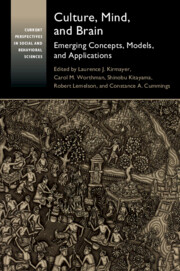Book contents
- Culture, Mind, and Brain
- Current Perspectives in Social and Behavioral Sciences
- Culture, Mind, and Brain
- Copyright page
- Dedication
- Epigraph
- Contents
- Figures
- Tables
- Contributors
- Preface
- Abbreviations
- 1 Introduction
- Part I Dynamics of Culture, Mind, and Brain
- Part II Applications
- 12 The Cultural Brain as Historical Artifact
- 13 Experience-Dependent Plasticity in the Hippocampus
- 14 Liminal Brains in Uncertain Futures
- 15 The Reward of Musical Emotions and Expectations
- 16 Literary Analysis and Weak Theories
- 17 Capturing Context Is Not Enough
- 18 Social Neuroscience in Global Mental Health
- 19 Cities, Psychosis, and Social Defeat
- 20 Internet Sociality
- 21 Neurodiversity as a Conceptual Lens and Topic of Cross-Cultural Study
- 22 Epilogue
- Index
- References
20 - Internet Sociality
from Part II - Applications
Published online by Cambridge University Press: 18 September 2020
- Culture, Mind, and Brain
- Current Perspectives in Social and Behavioral Sciences
- Culture, Mind, and Brain
- Copyright page
- Dedication
- Epigraph
- Contents
- Figures
- Tables
- Contributors
- Preface
- Abbreviations
- 1 Introduction
- Part I Dynamics of Culture, Mind, and Brain
- Part II Applications
- 12 The Cultural Brain as Historical Artifact
- 13 Experience-Dependent Plasticity in the Hippocampus
- 14 Liminal Brains in Uncertain Futures
- 15 The Reward of Musical Emotions and Expectations
- 16 Literary Analysis and Weak Theories
- 17 Capturing Context Is Not Enough
- 18 Social Neuroscience in Global Mental Health
- 19 Cities, Psychosis, and Social Defeat
- 20 Internet Sociality
- 21 Neurodiversity as a Conceptual Lens and Topic of Cross-Cultural Study
- 22 Epilogue
- Index
- References
Summary
This chapter offers a cultural epidemiology of digital communities, describing how these groups emerge, bond, and come to develop shared embodied experiences. We argue that online communities, while seemingly novel and often “strange," can offer insights into fundamental mechanisms of human sociality albeit on an unprecedented speed and scale due to specific affordances of cyberspace. After framing this argument, we outline a noncomprehensive anthropological survey of online communities of interest. Our hope is to provide a model for how online communities grow to share interphenomenal experiences despite lack of face-to-face interaction, and how this might inform our understanding of ordinary social cognition.
- Type
- Chapter
- Information
- Culture, Mind, and BrainEmerging Concepts, Models, and Applications, pp. 461 - 476Publisher: Cambridge University PressPrint publication year: 2020



